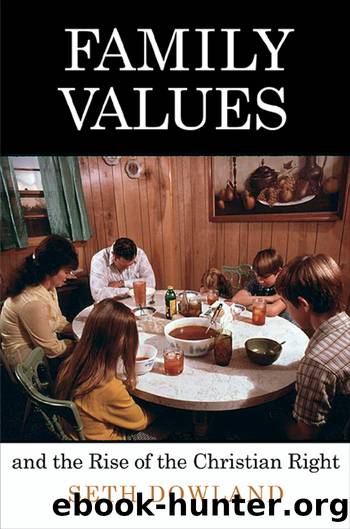Family Values and the Rise of the Christian Right by Seth Dowland

Author:Seth Dowland [Dowland, Seth]
Language: eng
Format: epub
Tags: History, United States, General, Religion, Christian Living, Religion; Politics & State
ISBN: 9780812247602
Google: Fk6xCgAAQBAJ
Publisher: University of Pennsylvania Press
Published: 2015-12-17T22:18:34+00:00
The ERA Debate
The internecine battles among evangelicals over gender roles and womenâs ordination took place alongside and in response to second-wave feminism. The âfirst waveâ of feminist activism came in the late nineteenth century, when activists like Susan B. Anthony and Elizabeth Cady Stanton campaigned for womenâs right to vote and to hold property rights and for equality in marriage. Many first-wave feminists drew on Christian teaching for support, though their critics often derided them as anti-religious. For instance, Stantonâs Womanâs Bible, published in 1895, offered feminist interpretations of certain passages of scripture and argued for a liberated reading of the Christian Bible. âWe have made a fetich [sic] of the Bible long enough,â she wrote. âThe time has come to read it as we do all other books, accepting the good and rejecting the evil it teaches.â51 Such a selective approach to scripture displeased Stantonâs conservative critics, who contended that the Womanâs Bible preached heresy. In spite of criticism from both evangelicals and biblical scholars, the book became a bestseller. First-wave feminism, then, depended in part on showing how Christianity supported womenâs rights.
Second-wave feminism, which won its greatest acclaim in the 1970s, was more wary of religious faith. Although women like Scanzoni and Hardesty argued that the Bible supported feminist teaching, the most prominent second-wave feminists disdained what they saw as the patriarchal culture of Christianity. Mary Daly, a feminist theologian at Boston College, condemned âChristian idolatryâ that put Jesus at the center of faith. She thought that womenâs liberation demanded that believers reject the centrality of Christ and embrace an androgynous spirituality. Daly proposed a âcastrationâ of Christianity that would remove âthe myths of sin and salvationâ that placed believers at the mercy of a male savior. In short, Daly demanded that spirituality accommodate womenâs liberation. She saw no future for a Christianity with Jesus at the center.52 Such a radical reinterpretation of traditional Christianity alienated evangelicals and, for many, marked second-wave feminism as a rejection of scripture.
Yet the efforts of evangelical feminists to maintain a more orthodox reading of the Bible alongside a commitment to womenâs liberation did pay dividends. In the early 1970s, a majority of Christians seemed supportive of the overarching goal of second-wave feminism: enabling women to achieve equality in all walks of life. Conservative Christiansâ openness to feminist advances in the early 1970s depended in part on the seemingly benign wording of the Equal Rights Amendment, feminismâs most notable policy goal. The ERA, which passed Congress in 1972, read like a simple guarantee of womenâs full and equal participation in modern society:
Section 1. Equality of rights under the law shall not be denied or abridged by the United States or by any state on account of sex.
Section 2. The Congress shall have the power to enforce, by appropriate legislation, the provisions of this article.
Section 3. This amendment shall take effect two years after the date of ratification.
Download
This site does not store any files on its server. We only index and link to content provided by other sites. Please contact the content providers to delete copyright contents if any and email us, we'll remove relevant links or contents immediately.
| Buddhism | Christianity |
| Ethnic & Tribal | General |
| Hinduism | Islam |
| Judaism | New Age, Mythology & Occult |
| Religion, Politics & State |
Cecilia; Or, Memoirs of an Heiress — Volume 1 by Fanny Burney(31348)
Cecilia; Or, Memoirs of an Heiress — Volume 3 by Fanny Burney(30946)
Cecilia; Or, Memoirs of an Heiress — Volume 2 by Fanny Burney(30905)
The Secret History by Donna Tartt(16651)
Sapiens: A Brief History of Humankind by Yuval Noah Harari(13068)
Leonardo da Vinci by Walter Isaacson(11914)
The Radium Girls by Kate Moore(10914)
Sapiens by Yuval Noah Harari(4548)
The Wind in My Hair by Masih Alinejad(4427)
How Democracies Die by Steven Levitsky & Daniel Ziblatt(4407)
Homo Deus: A Brief History of Tomorrow by Yuval Noah Harari(4287)
Endurance: Shackleton's Incredible Voyage by Alfred Lansing(3852)
The Silk Roads by Peter Frankopan(3772)
Man's Search for Meaning by Viktor Frankl(3646)
Millionaire: The Philanderer, Gambler, and Duelist Who Invented Modern Finance by Janet Gleeson(3574)
The Rape of Nanking by Iris Chang(3523)
Hitler in Los Angeles by Steven J. Ross(3444)
The Motorcycle Diaries by Ernesto Che Guevara(3341)
Joan of Arc by Mary Gordon(3263)
